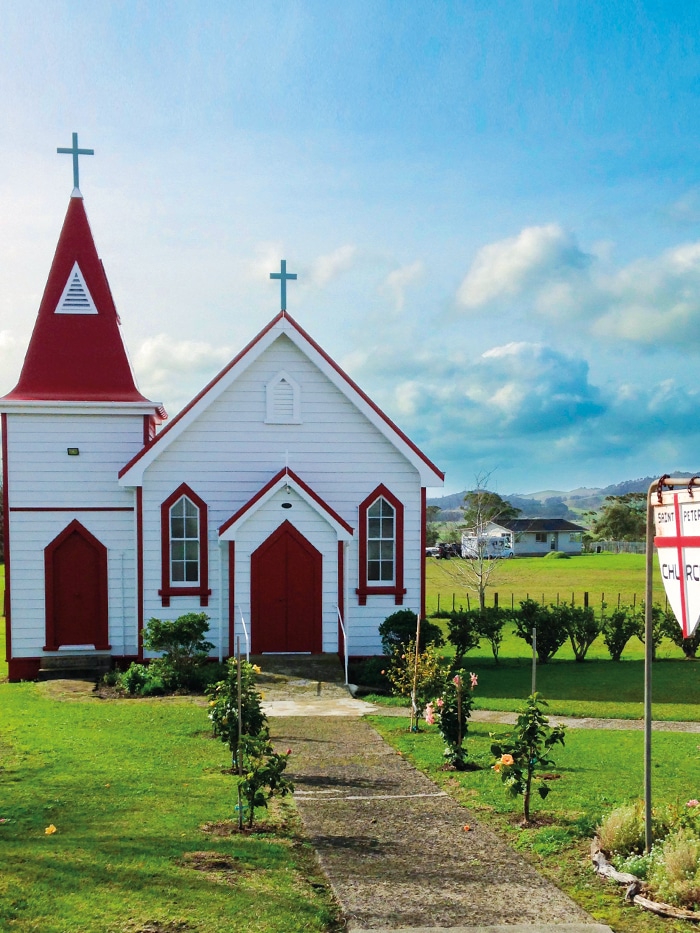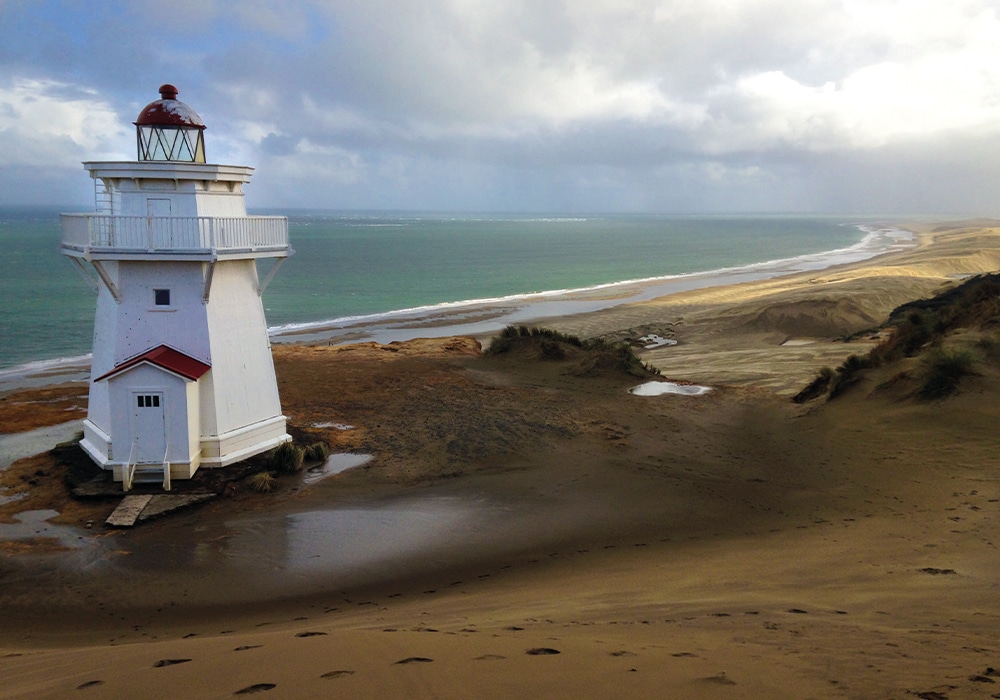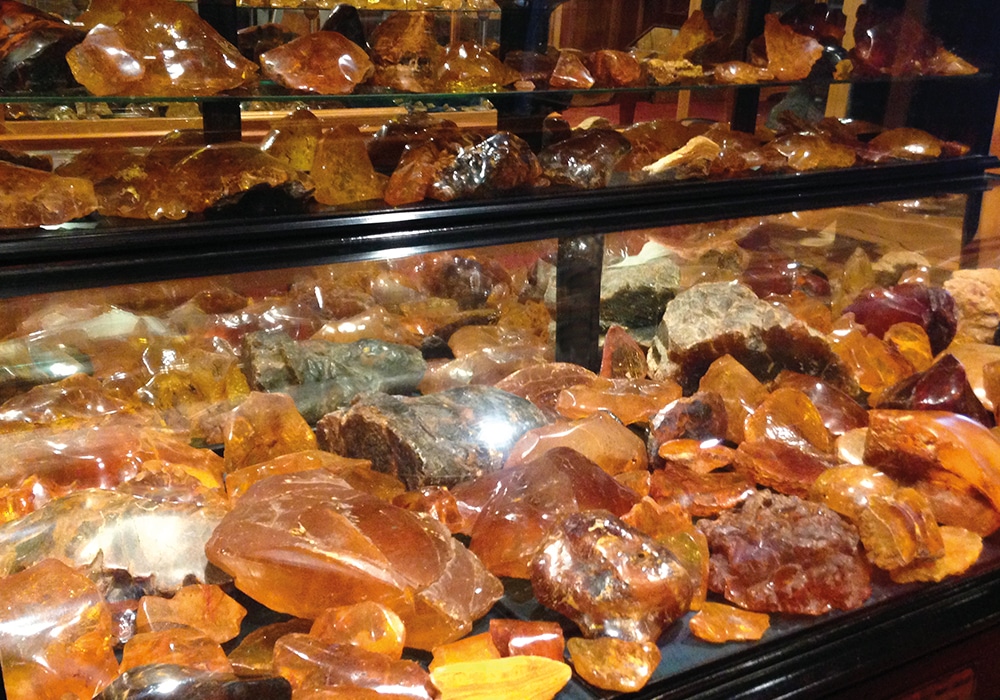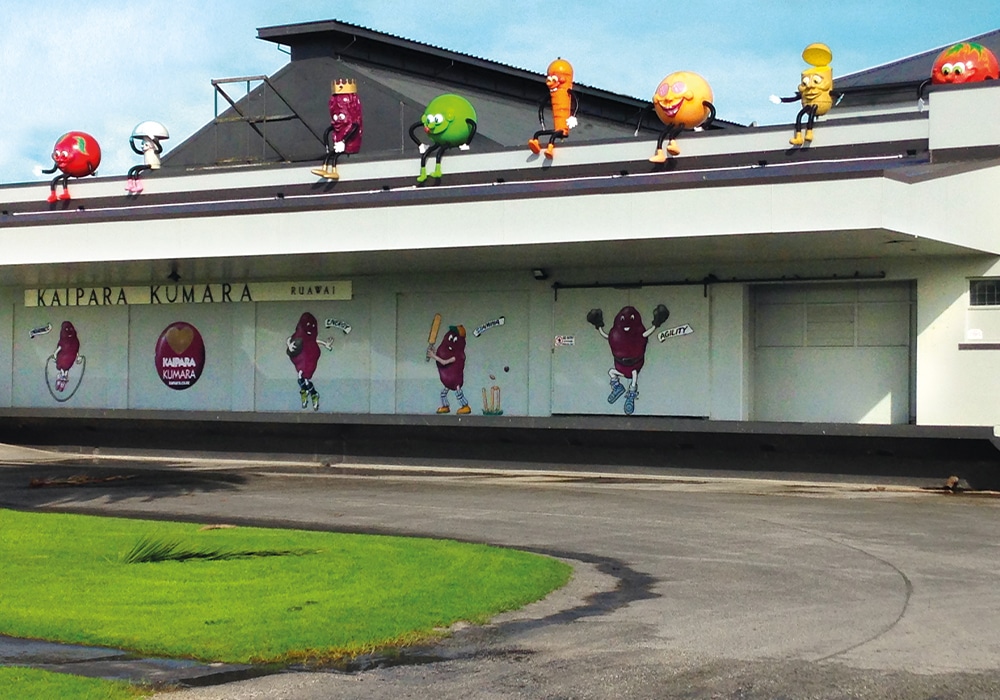Eleanor Hughes finds history and natural beauty when she combined a Kaipara campervan roadie with one of Northland’s cycling trails.
Leaving West Auckland for the Kaipara region with my friend Lisa in her recently purchased campervan, a four-berth 1998 Ford Transit, we only had two plans – to walk from Pouto Point to Kaipara North Head Lighthouse, and to cycle a section of the scenic 87km-long Pou Herenga Tai Twin Coast Cycle Trail.
Driving on SH16 took us through Helensville with its historic post office, railway station museum, Kaipara River and old villas; past Gibbs Farm, its gigantic sculptures standing out on green hills, and the road to Port Albert, just before Wellsford. So close to home, and such history…we started planning a trip back before we’d even got very far. At Brynderwyn junction we turned westwards onto SH12, reaching Paparoa not long after. An eye-catching, pale blue, wooden B&B was once the old post office, built circa 1903. Little was happening at the general store, opposite the old BNZ and sadly, 1950s retro-style Paparoa Hotel is closed on Mondays. Lunch in the campervan, then.
Close to town, a 7km road leads to Pahi Peninsula’s end jutting into the Kaipara Harbour. A grand, wooden building with sash windows, once the Pahi Hotel, stands on its foreshore. Built around 1897, its second-storey verandah would have been perfect to view the annual regatta, first sailed in 1887. Whakapirau Wharf stretched out from the opposite coastline where a smattering of houses dotted the hill beyond. The cream-coloured Pahi Community Hall, once the general store, has stood nearby Pahi wharf since it was built in the late 1800s.
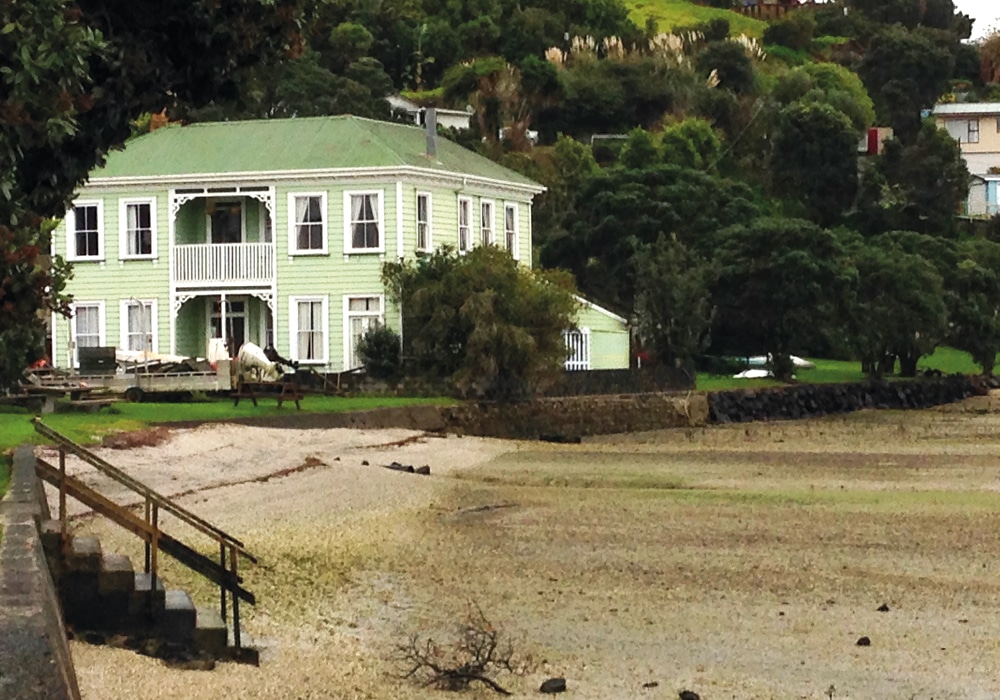
Kauri in Matakohe
Arriving just an hour before Matakohe Kauri Museum closed at 5pm, we were delighted to discover our tickets were also valid for the following day, because the place is huge. The two-storey replica of Otamatea Boarding House featured rooms displaying tableaux of travellers who would have stayed, including a kauri gum buyer, dentist, banker and timber buyer. Its balcony looks over a steam sawmill with moving saws and steam engines.
Matakohe Holiday Park is only 650m from the museum, so we returned at 9.30am, to spend another 1½ hours learning and discovering. I know lots about the kauri industry now! The 5000 odd golden kauri pieces were very impressive too. The neighbouring wooden post office, operating from 1909 to 1988, displays the phone exchange’s original equipment, including some bygone telephones. Matakohe Pioneer Church Hall, erected in 1867, is opposite, with views from the neighbouring cemetery over Arapaoa River and the wavy green coastline of Kaipara Harbour’s northeastern arm.
Kaipara North Head: Lighthouse Bound
Ruāwai’s Kaipara Kumara warehouse is easy to spot, with giant Big Fresh vegetable characters perched on its roof. We stopped to buy kumara; you have to, don’t you? Tokatoka Peak interrupted kilometres of flat farmland. We drove through Dargaville and onto the Pouto Peninsula. Green rolling hills contrasted with the brownish Wairoa River. A shrub-lined pathway led to the early 1900s white, wooden Saint Peters church with its cross-tipped belfry tower, in the small settlement of Te Kopuru. Barely 100m further on, the 1890s school building, a small bell tower above its verandah, remains part of Te Kopuru School.
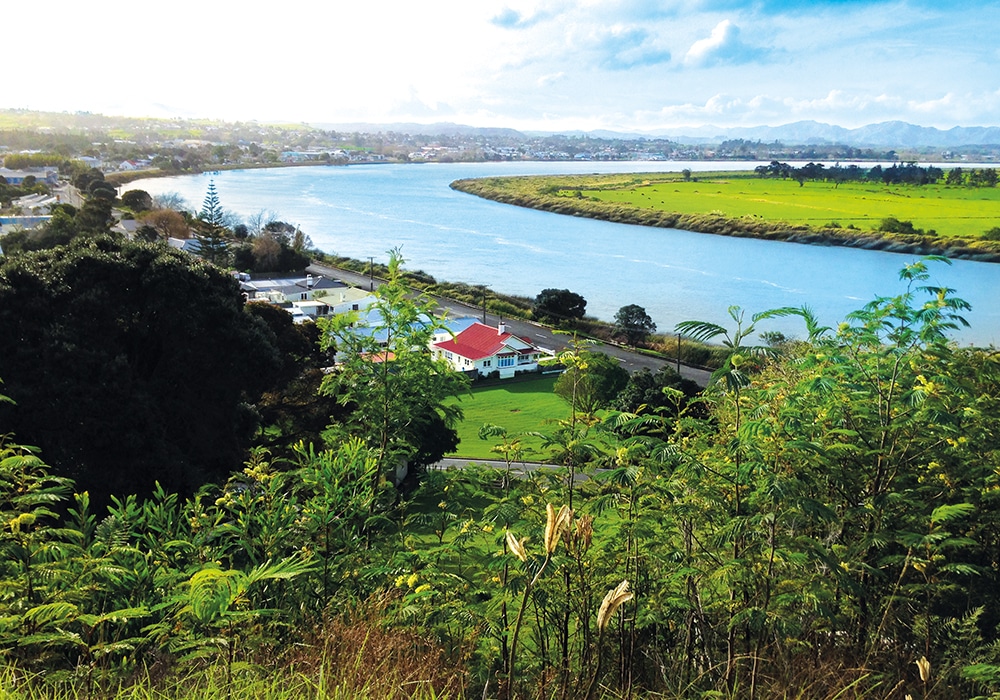
Eventually, the countryside gave way to pine forest. Eleven kilometres from Pouto Point, we hit gravel, the road winding through more farmland. We’d timed our 7km walk to the lighthouse around Pouto Beach’s 3pm low tide. Battling a headwind, swirling sand stinging my face, I followed a roped-off area where dotterel and oystercatchers nest near the high-tide mark. The golden sand beach stretched forever, edged with tree-covered, blackish, low sand dunes which became higher and oranger the farther we walked. Luckily, two girls gave us a lift in a Polaris 30 minutes in, dropping us at the base of white dunes rippled with black sand.
Set back from their crest, almost obscured, it took 20 minutes to climb to the hexagonal, wooden lighthouse, built in 1883-84 and abandoned in 1952. Wind buffeted, I viewed the sandy coastline. Opposite, moody clouds blended with South Head’s distant coast. On the return walk, what I thought were rocks protruding from the sand was in fact soft, crumbly black lignite – remnants of vegetation buried by sand over 35,000 years ago. Branches were partially embedded in some, wood petrified in others. The area is known as ‘the place of hidden treasures’, and it was exciting to spot weathered, wooden planks joined by rusted metal bolts jutting from the beach, perhaps part of a ship’s hull. It’s definitely a place to let the imagination run wild.
Discovering Dargaville
Retracing our drive for around 11km, we turned onto a gravel road to travel the 6km to Kellys Bay Camping Reserve. Here, olld-fashioned baches and more upmarket homes lining the waterfront weren’t appreciated until the morning light.
Kauri history, shipping and shipwrecks, Dalmation settlers, early Dargaville businesses and the Rainbow Warrior bombing engrossed us for two hours at Dargaville Museum, with replica gum diggers’ huts in the grounds, before we retreated to Dargaville Holiday Park and Motels for the night.
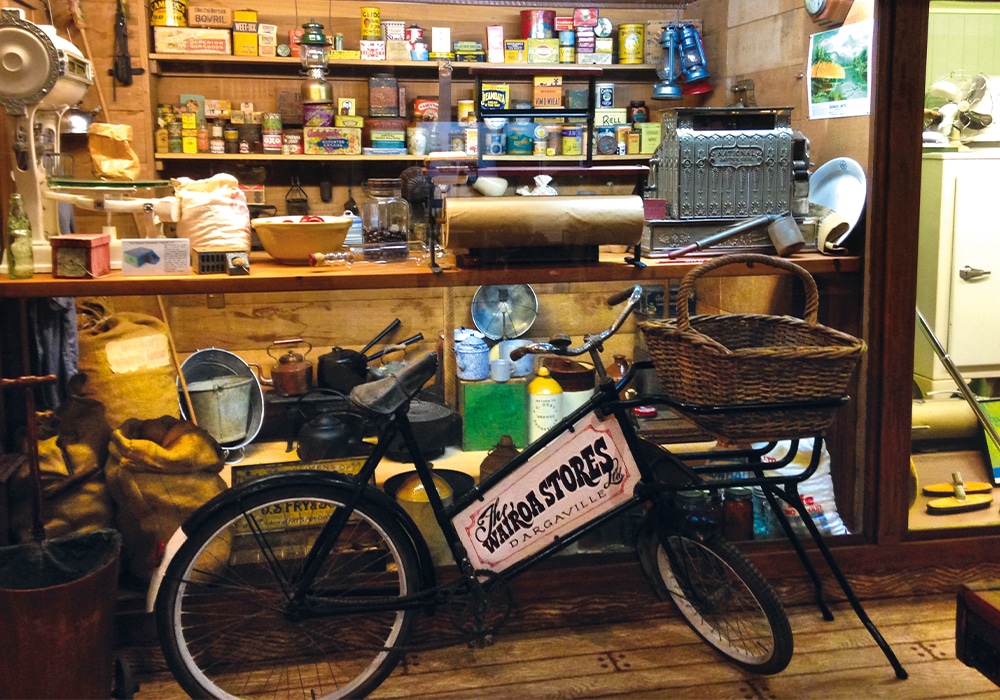
Rain the next day necessitated a change of plans, and we drove the Amber Threads historical walking trails. The trails are being reinvigorated from the Millennium Project, which created the first historic riverwalk in 2000; the mostly flat walk takes around 90 minute to two hours. We viewed late 1800s’ two-storeyed, wooden hotels, 1800s’ bungalows riverside, Mt Wesley Cemetery, and on Kaihu River’s banks, Manchurian Rice Grass. It had grown from seed-packed clay bricks used as ship’s ballast which were tossed overboard when the kauri logs were loaded on board.
Kaikohe and Pou Herenga Tai Twin Coast Cycle Trail
Winding through lush, green, flattish land hemmed by rolling hills, SH15 led us to Kaikohe. Four kilometres from town, we stayed at the NZMCA campsite at Kaikohe A&P Showgrounds & Equestrian Centre. Sadly for us, the recently refurbished and reopened Ngawha Springs Hot Pools, 3km away, were fully booked… no soaking for us.
Pou Herenga Tai Twin Coast Cycle Trail was fully opened in early 2017. Half of it follows a railway corridor; other sections traverse privately owned land or country roads. The trail is managed by a charitable trust with representatives from landowners, and local communities, Māori and two council appointed trustees, and the mainly compacted, shale-surfaced trail is well looked after.
At the time of writing, a section between Opua and Kawakawa was closed due to a historic railway line reinstatement; however an alternative road route between the two towns along a ridge with views including the inner Bay of Islands, native forest and rural farmland, is planned to open by Christmas 2022. The 76km trail is rideable from Kawakawa to Māngungu Mission House on Hokianga Harbour.
With mountain bikes hired from Top Trail and a 3pm shuttle from Kawakawa back to Kaikohe organised, we departed the Kaikohe depot at 10am, cycling Okaihau-bound. An easy 14km through countryside and native bush, we stopped to read of the fascinating medicinal value of natives: red matipo can thin the blood; mashed kahikatea leaves treat kidney and urinary complaints; and puriri leaves soothe muscle aches. It makes you wonder why we don’t make better use of these natural resources.
Further on the pitch-black, 1915-built, 80-metre tunnel was tricky until daylight glowing from its far entrance guided us out. The trail descended to Lake Omapere, the largest lake in Northland, covering 14m² and the ancestral home of the indigenous eel. Outside Okaihau Hall, colourful history boards tell of the town’s local businesses. The garage and butchery still operate, but other buildings on the main street stand empty. Pale-blue Kiwi Kai on the Waihou looked inviting but we had just under three and a half hours to ride the 48km to Kawakawa…no time to stop!
However, once in Kaikohe at 1pm, the trail’s highest point, we wolfed down picnic lunches and cycled on. The undulating country trail passes the concrete platform that is all that remains of Kaikohe Railway Station, closed in 1987. Weatherboards were missing on an old home, horses grazing outside it. Blue paint peeled off Orauta School’s building, its upper windows boarded up. In Ngapipito River Valley, the 74m Kawiti Truss Bridge carried us over Orauta Stream. Te Rito Marae was well kept. Despite our best efforts, it became obvious, as we passed the kilometre markers, we weren’t going to make our 3pm pickup. We quickly phoned Top Trails, before pedalling a bit faster!
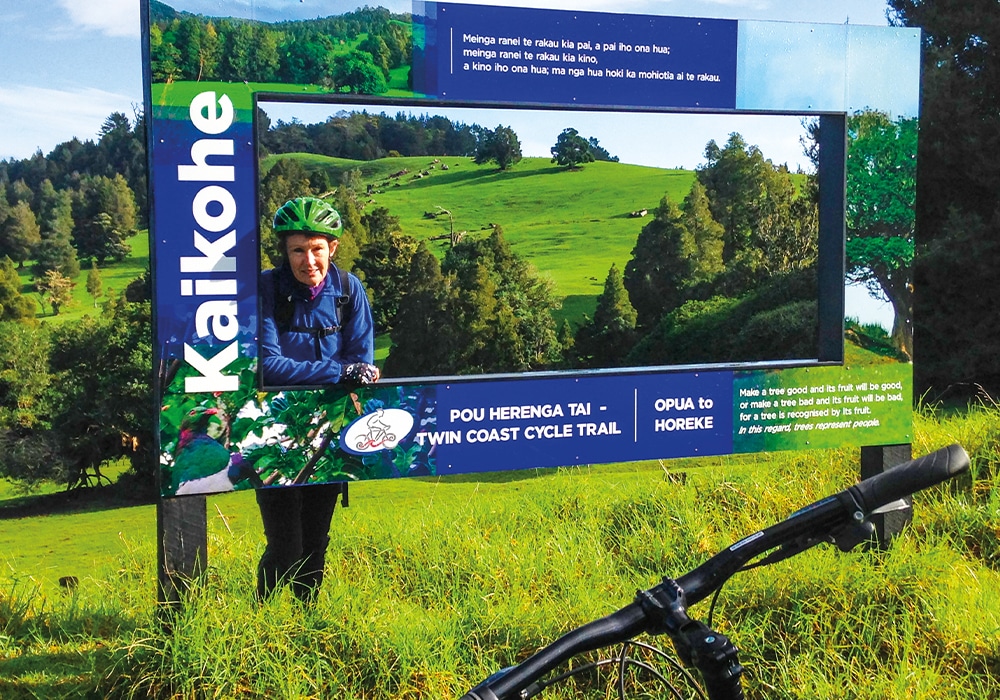
Defunct railway crossing signs stand nearby Ōtiria Marae, a carved, whitecloaked figure on the apex of its meeting house. Passing the Affco freezing works near Moerewa, a disused timber mill, and backyards, we reached Kawakawa’s Railway Station at 4pm. Next to the colourful Te Hononga Hundertwasser Memorial building, its gallery closed, our driver was waiting patiently. On the drive back to Kaikohe, we learned that there are eight volcanoes in the vicinity, one of which is a burial mountain that was still being used up until about 20 years ago. The vent at the top is covered by a boulder which was rolled off and bodies lowered by rope into it. Unfortunately, Kaikohe’s Pioneer Village, a five-acre outdoor museum with historic buildings, was closed when we arrived, so we decamped to Whangarei’s Top Ten Holiday Park for the evening.
Wending our way South
Next morning, Waipu Museum was an interesting stop on our way to Mangawhai. I learned of its Scottish Highlander settlers’ journey to Nova Scotia, then Melbourne and onto Auckland before finding ‘paradise’ in Waipu. Waves lapped at beautiful Langs Beach. Further south, Mangawhai Heads Holiday Park sits on the edge of Mangawhai Harbour’s soft sand with views to the opposite sandspit. Boats motored the protected inlet from the nearby ramp as we walked southwards along the waterfront to stairs with views of the glistening Pacific and distant Hen Island. Next morning, the famous Bennetts of Mangawhai Chocolate Shop, 6km from the camping ground, was open, and hard to resist. Being Sunday, the glassed-off workspace was empty of chocolatiers. Delicious aromas emanated from their popular Mediterranean style-café next door.
Homeward bound in the camper, close to 750km later, I enjoyed the block of Bennetts’ Blueberry in Milk Chocolate (with real berry bits) and we began planning our next road trip. What a great way to travel this is.
Route taken
Day 1: SH16 from West Auckland to Wellsford, then SH1 to Brynderwyn Junction. Onto SH12 to stay at Matakohe.
Day 2: SH12 to Dargaville, and Pouto Road to Pouto Point. Backtracking to Kellys Bay Road and staying at Kellys Bay Camping Reserve.
Day 3: Continued along Kellys Bay Road to Pouto Road and stayed in Dargaville at Dargaville Holiday Park and Motels.
Day 4: SH14 from Dargaville and onto SH15 to Kaikohe. Stayed at NZMCA campsite at Kaikohe A&P Showgrounds & Equestrian Centre.
Day 5: Cycled Pou Herenga Tai Twin Cycle Trail – Kaikohe to Okaihau, back to Kaikohe and onto Kawakawa. Shuttle back to Kaikohe before driving to Whangarei Top10 Holiday Park via SH12 then SH1.
Day 6: Whangarei to Waipu on SH1, then Cove Road and Mangawhai Heads Road to Mangawhai Heads Holiday Park.
Day 7: Mangawhai Heads to West Auckland via Molesworth Drive, Kaiwaka Mangawhai Road, SH1, then SH18 and SH16.
The details
• For camping options: nzmca.org.nz
• Matakohe Kauri Museum: kaurimuseum.com
• Dargaville Museum: dargavillemuseum.co.nz
• Pou Herenga Tai Twin Coast Cycle Trail: twincoastcycletrail.kiwi.nz
• Top Trail: toptrail.co.nz
• Pioneer Village, Kaikohe: pioneervillage.org.nz
• Waipu Museum: waipumuseum.com
• Bennetts of Mangawhai: bom.co.nz
• Mangawhai Museum: mangawhai-museum.org.nz
